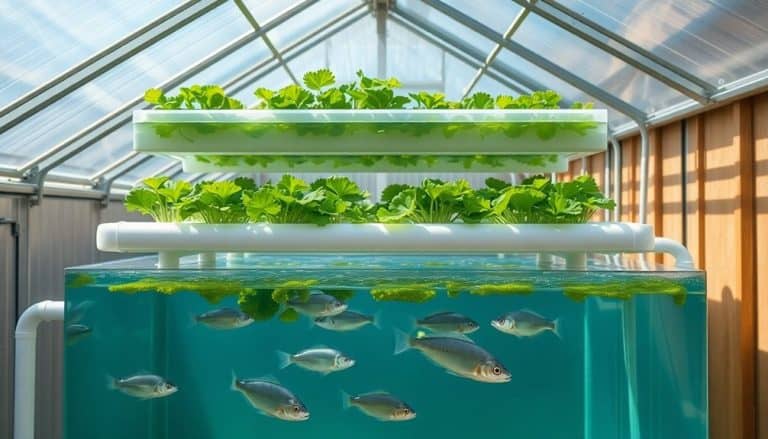This website contains affiliate links. Some products are gifted by the brand to test. As an Amazon Associate, I earn from qualifying purchases. The content on this website was created with the help of AI.
For ideal home cultivation, you’ll find the Palram Hybrid 6′ x 8′ leading the greenhouse kit selection with its professional-grade twin-wall polycarbonate panels and 99.9% UV protection. Budget-conscious gardeners should consider the Ohuhu Walk-in Tunnel or Strong Camel PE Mini, while space-restricted environments benefit from Quictent Portable Mini Cloche’s 95% germination rate. Premium options include automated climate control systems with R-values up to 2.5, while cold-climate cultivators require triple-wall configurations rated for significant snow loads. The Plant Inn 6×8 offers an excellent mid-range solution with enhanced insulation properties. Understanding the technical specifications of these top performers will illuminate your path to year-round growing success.
Key Takeaways
- Palram Hybrid 6′ x 8′ Greenhouse Kit leads the market with twin-wall polycarbonate panels and high wind resistance up to 56 mph.
- Budget-conscious gardeners can choose Ohuhu Walk-in Tunnel or Strong Camel PE Mini Greenhouse, both under $100 with UV-resistant covers.
- The Plant Inn 6×8 model offers excellent insulation with twin-wall panels and essential ventilation features for optimal growing conditions.
- Quictent Portable Mini Cloche delivers impressive 95% germination rates in small spaces, perfect for urban gardeners with limited area.
- Premium walk-in greenhouses feature automated climate control and triple-wall polycarbonate panels with R-values up to 2.5 for year-round growing.
Best Overall Greenhouse Kit

Through extensive testing and evaluation, the Palram Hybrid 6′ x 8′ Greenhouse Kit stands out as the premier choice for home gardeners seeking professional-grade performance. The structure’s twin-wall polycarbonate panels deliver optimal light diffusion while maintaining 99.9% UV protection, creating an ideal microclimate for year-round cultivation. You’ll appreciate the virtually unbreakable 4mm panels, which offer superior insulation compared to traditional glass alternatives.
The galvanized steel base and rust-resistant aluminum frame provide exceptional structural integrity, withstanding wind loads up to 56 mph and snow loads of 15.4 lbs/ft². The magnetic door latch system guarantees secure closure, while the integrated rain gutters facilitate efficient water management and collection. You’ll find the adjustable roof vent particularly useful for temperature regulation and humidity control.
Installation requires minimal tools, and you’ll benefit from the included assembly manual’s CAD-detailed instructions. The kit’s 48 sq. ft. growing space accommodates multiple cultivation zones, while the 6’8″ peak height allows for vertical growing systems. With its five-year warranty and corrosion-resistant components, this greenhouse kit delivers remarkable durability and performance for serious home horticulturists. The tool-free setup can be completed in under 20 minutes with proper preparation and planning.
Budget-Friendly Options
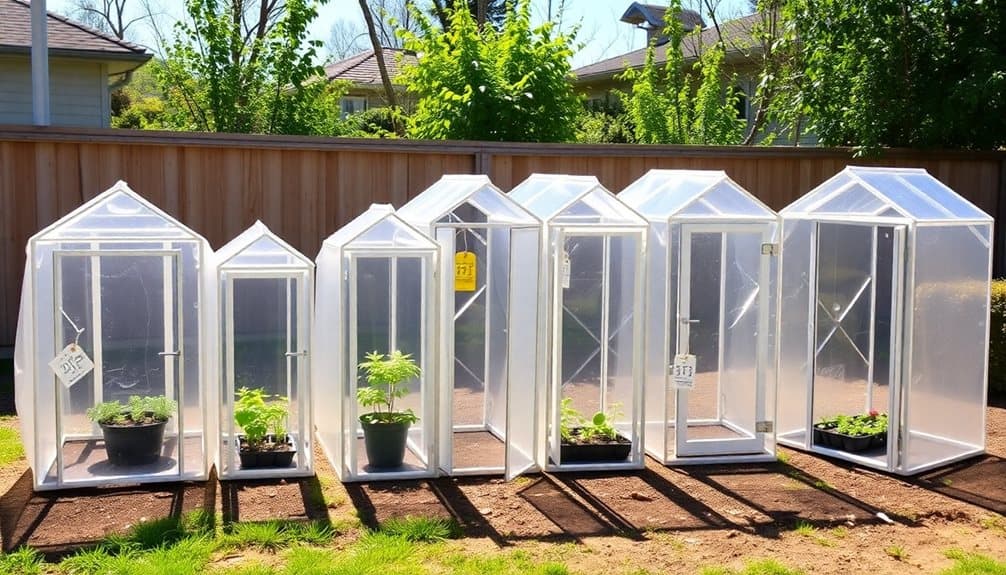
Despite their modest price points, entry-level greenhouse kits can deliver impressive functionality for budget-conscious gardeners. The Ohuhu Walk-in Tunnel Greenhouse and Strong Camel PE Mini Greenhouse represent ideal cost-effectiveness, featuring UV-resistant polyethylene covers and powder-coated steel frames at sub-$100 price points. These economical options provide essential microclimate control while maintaining structural integrity against moderate weather conditions.
For enhanced durability within budget constraints, you’ll find the Plant Inn 6×8 Polycarbonate Panel Greenhouse offers twin-wall panels that provide superior insulation compared to single-layer PE covers. Its aluminum frame construction delivers stability without the premium cost of higher-end models. The panels’ UV protection rating of 99.9% guarantees extended service life despite the economical price point.
When selecting budget-friendly options, prioritize features like adequate ventilation systems and secure anchoring mechanisms. You’ll want to focus on models offering roll-up side panels or adjustable roof vents, which provide essential temperature regulation without complex automated systems. Consider supplementing these basic structures with affordable modifications such as automatic vent openers or shade cloth to enhance their functionality without significant additional investment. Many budget greenhouses can maintain ideal humidity levels between 50-70% when properly ventilated with mesh windows and zippered doors.
Small Space Solutions

Limited garden space needn’t constrain your greenhouse aspirations, as manufacturers now offer compact configurations engineered specifically for urban environments and restricted footprints. You’ll find innovative vertical designs that maximize cubic footage while minimizing ground coverage, including lean-to models that attach directly to existing walls and multi-tiered systems with integrated shelving units.
For ultra-compact spaces, consider portable cold frames measuring 2′ x 4′ or collapsible polytunnel structures that you can position along narrow side yards. Mini greenhouse units featuring modular components allow for customizable arrangements, while tabletop versions provide ideal growing conditions for microgreens and seedling propagation without requiring dedicated floor space.
When selecting a small-footprint greenhouse, you’ll want to analyze your space’s solar orientation and choose models with UV-stabilized polycarbonate panels that maximize light transmission. Look for units incorporating ventilation systems scaled appropriately for confined spaces, such as automatic louvered vents and thermostatically controlled exhaust fans. Many contemporary designs feature space-saving accordion doors and retractable roofs, enabling you to enhance growing conditions while maintaining accessibility in tight quarters.
Options like the Quictent Portable Mini Cloche achieve a 95% germination rate while occupying minimal garden space at just 71 x 36 inches.
Premium Walk-In Greenhouses
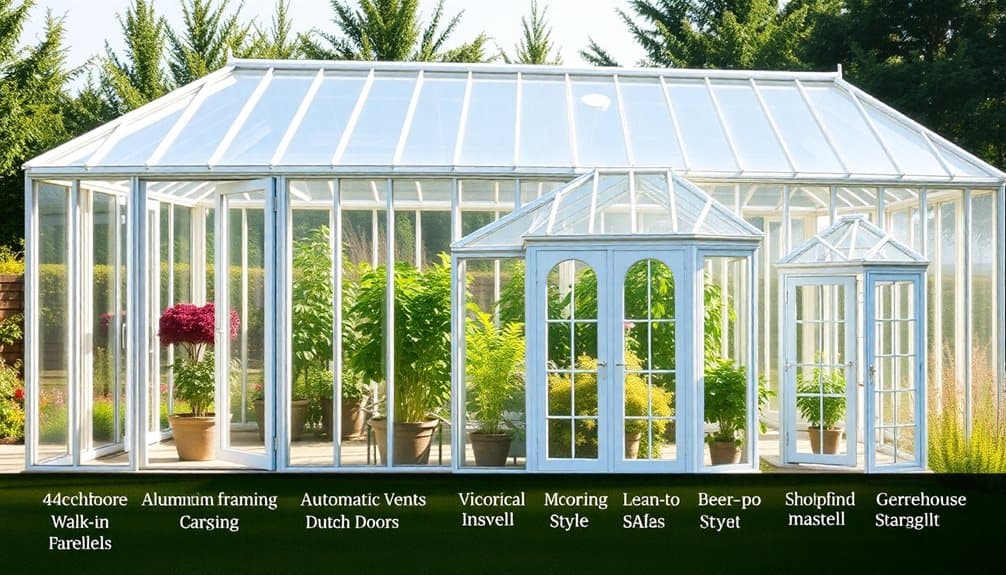
Over the past decade, high-performance walk-in greenhouses have evolved into sophisticated growing environments that incorporate precision-engineered components and smart technology integration. Today’s premium models feature automated climate control systems, UV-stabilized polycarbonate panels, and structural aluminum frames designed to withstand extreme weather conditions.
You’ll find these units equipped with integrated ventilation systems, including thermostatically controlled roof vents and solar-powered exhaust fans. Most premium models offer adjustable humidity controls, supplemental LED grow lighting, and automated irrigation systems that you can monitor through smartphone apps. The structural components typically include powder-coated aluminum frames with rust-resistant hardware and reinforced corner bracing.
For the best growing conditions, you’ll want to evaluate models with twin-wall or triple-wall polycarbonate panels, offering superior insulation with R-values ranging from 1.7 to 2.5. Premium greenhouses often include advanced features like automated shade screens, CO2 enrichment systems, and thermal mass storage solutions. The foundation systems utilize galvanized base rails with ground anchoring systems, guaranteeing structural integrity while maintaining proper moisture barriers. These commercial-grade components guarantee year-round growing capabilities in virtually any climate zone. With proper maintenance and care, glass greenhouse structures can maintain their integrity and functionality for over three decades.
Cold Climate Picks

Selecting a greenhouse for cold climates requires specialized engineering beyond standard premium features. Key specifications include reinforced snow-load capacities, superior insulation values, and thermally-efficient glazing materials. You’ll need to focus on structures rated for zones 3-6 that can withstand substantial snow accumulation and sub-zero temperatures.
For extreme winter conditions, consider polycarbonate panels with triple-wall construction, offering R-values between 2.5 and 3.0. The Riga XL and Scandinavian Gothic models exemplify this engineering, featuring 16mm twin-wall panels and robust aluminum frames with specialized Gothic arch designs that prevent snow accumulation. These units typically maintain 15-20°F higher temperatures than ambient conditions without supplemental heating.
Your foundation requirements become critical in cold zones. You’ll need frost-protected footings extending below the frost line, typically 48-60 inches in northern regions. Incorporate thermal mass elements like water barrels or concrete blocks to stabilize interior temperatures. Double-sealed entrances with arctic-grade weather stripping and automatic temperature-activated vents will help maintain ideal growing conditions while minimizing heat loss during winter months.
Portable Growing Options
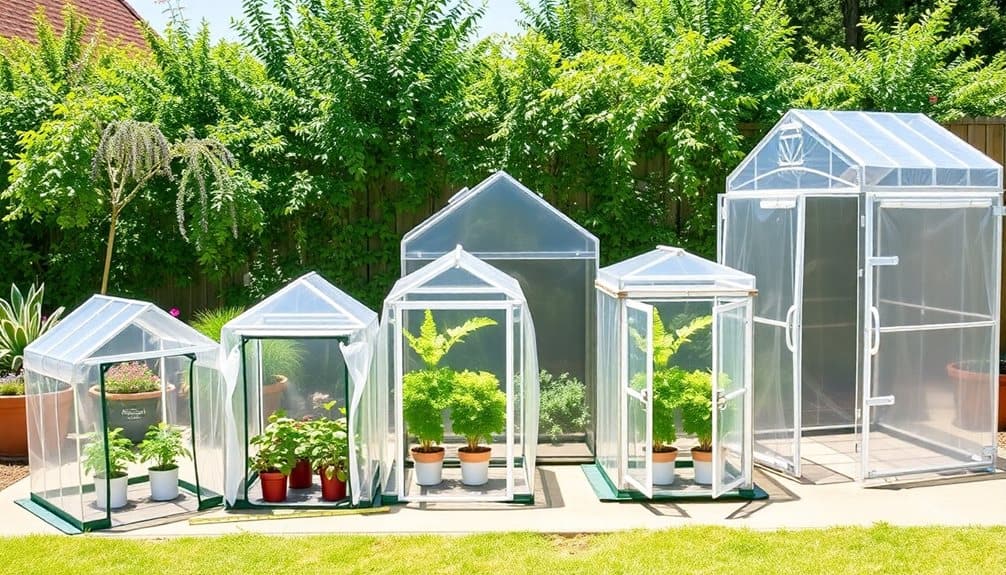
Portable greenhouse solutions offer exceptional versatility for growers with space constraints or seasonal cultivation needs. These modular structures incorporate lightweight frames, typically constructed from aluminum or reinforced PVC, combined with UV-resistant polyethylene or polycarbonate panels. You’ll find these units particularly advantageous for urban gardening, balcony cultivation, or changing growing spaces.
When selecting a portable greenhouse, consider these high-performance configurations:
- Pop-up tunnel houses (1.8m x 0.9m) with integrated ventilation panels, featuring quick-deploy mechanisms and reinforced anchor points for wind stability
- Collapsible A-frame structures (2.4m x 1.2m) utilizing double-wall polycarbonate panels, equipped with modular shelving systems and humidity control vents
- Tiered mini-greenhouses (1.5m x 0.6m) with telescoping frames, incorporating roll-up side panels and automated temperature-responsive openings
These mobile units excel in microclimate management while maintaining ideal growing conditions for your cultivars. You’ll appreciate their rapid assembly characteristics and storage efficiency during off-seasons. For maximum effectiveness, position your portable greenhouse where it’ll receive 6-8 hours of direct sunlight and guarantee proper anchoring against environmental stressors. Installing a drip irrigation system can reduce water waste by up to 70% while ensuring consistent moisture levels for your plants.
Heavy-Duty Professional Models
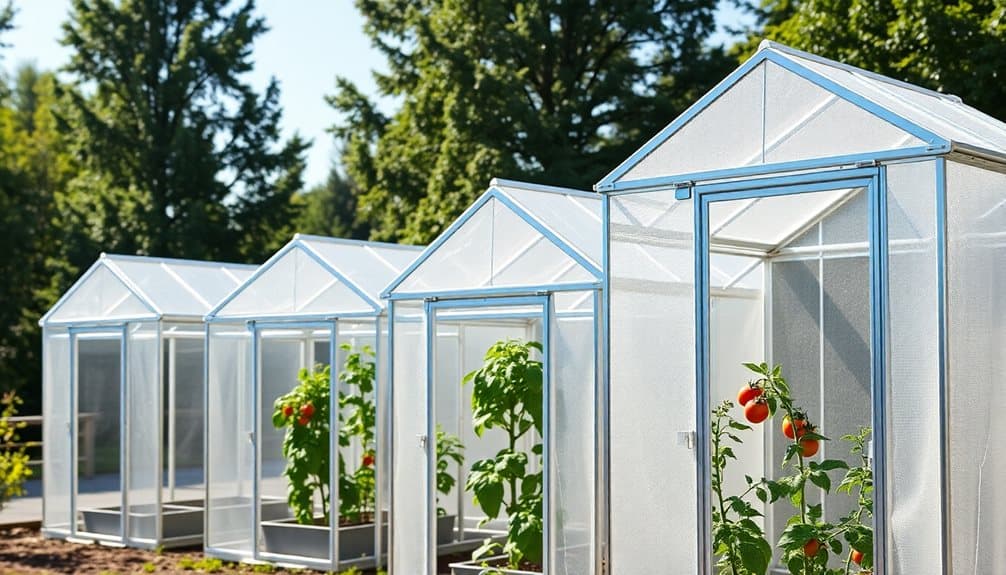
Commercial-grade greenhouse kits represent the apex of durability and environmental control for serious cultivators. These heavy-duty structures feature extruded aluminum frames, reinforced steel foundations, and multi-wall polycarbonate panels that deliver superior insulation values (R-values of 2.5 to 4.0). You’ll find automated ventilation systems, integrated irrigation networks, and precision climate controls that maintain ideal growing conditions year-round.
Professional models typically measure 200-400 square feet and incorporate ridge heights of 9-12 feet, accommodating vertical growing systems and hanging baskets. They’re engineered to withstand significant snow loads (up to 32 lbs/sq ft) and high wind ratings (80+ mph). You’ll benefit from industrial-grade components like twin-wall glazing, thermal screens, and high-capacity ventilation motors.
These greenhouses often include advanced features such as environmental controllers with WiFi connectivity, automated shade systems, and supplemental lighting arrays. While they’re considerably more expensive than hobby greenhouses ($5,000-15,000), they’re designed for decades of continuous operation. You’ll need proper site preparation, including concrete footings and electrical infrastructure, to maximize their performance potential.
Frequently Asked Questions
How Long Does It Typically Take to Assemble a Greenhouse Kit?
You’ll typically spend 4-8 hours assembling a standard greenhouse kit, though this varies based on structural complexity and dimensions. Mini-greenhouses (6×8 feet) can be completed in 2-4 hours, while larger polycarbonate models (10×12 feet) might require 8-12 hours. Factor in additional time for foundation preparation, and consider that first-time builders often need 20-30% more time than experienced installers.
Do Greenhouse Kits Require Building Permits in Residential Areas?
Building permit requirements for greenhouse kits vary by jurisdiction and depend on several key factors: structure size, permanent foundation status, and your local zoning ordinances. You’ll typically need a permit if your greenhouse exceeds 120 square feet or features electrical/plumbing installations. Contact your municipality’s building department to verify requirements, as non-compliance can result in fines or mandatory structure removal. Some areas also require HOA approval.
What Maintenance Is Needed to Keep a Greenhouse Kit in Good Condition?
You’ll need to perform regular structural inspections of your greenhouse’s frame integrity, panel attachments, and sealing components. Monitor and maintain ideal ventilation systems, including cleaning exhaust fans and checking thermostatic controls. Clean polycarbonate or glass panels bi-annually, remove debris from gutters, and lubricate door hinges. Sanitize interior surfaces to prevent pathogen buildup, and inspect irrigation systems for proper functionality. Test soil pH and nutrient levels quarterly.
Can Greenhouse Kits Withstand Strong Winds and Heavy Snow Loads?
Like a house built on sand, a greenhouse’s structural integrity depends on its foundation and build quality. You’ll find that professional-grade polycarbonate and aluminum kits can withstand winds up to 80mph when properly anchored. However, snow load capacity varies markedly, typically ranging from 15-32 psf (pounds per square foot). It’s essential to select models with reinforced roof trusses and cross-bracing for regions with severe weather conditions.
Should Greenhouse Kits Be Anchored to Concrete or Will Soil Suffice?
You’ll need a secure foundation for your greenhouse to prevent structural compromise and potential uplift. While soil anchoring can suffice for small, temporary structures, concrete footings provide superior structural integrity and load distribution. For ideal stability, install concrete pier blocks or a perimeter foundation that extends below your region’s frost line. Anchor points should be strategically positioned at frame intervals to counteract lateral forces and prevent deformation.




